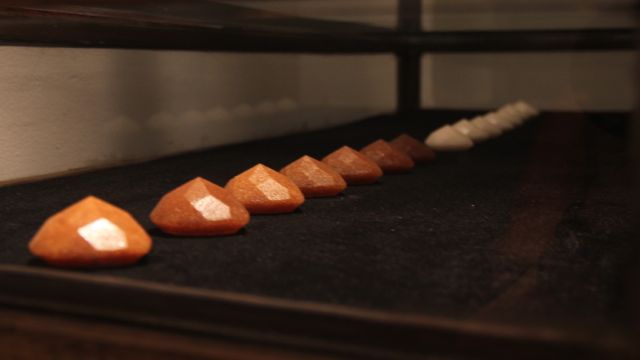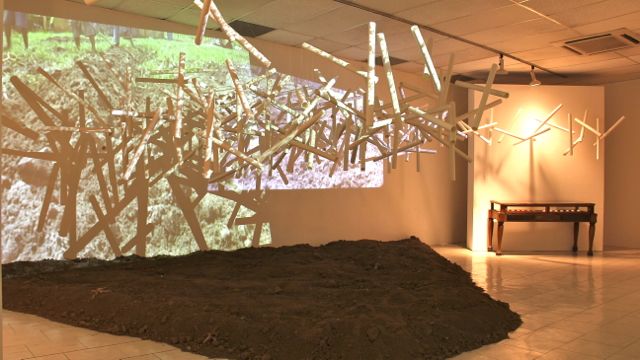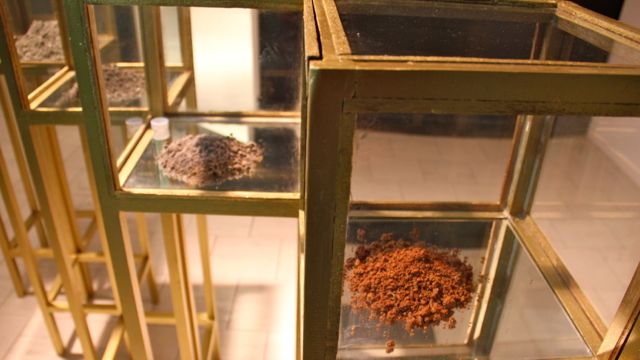SUMMARY
This is AI generated summarization, which may have errors. For context, always refer to the full article.

MANILA, Philippines – Artist Nikki Luna has kind eyes.
The statuesque morena can easily find her place in the middle of the “party” crowd, of whose photos we see in society pages.
But Nikki doesn’t live to be beautiful, to party, to be popular. Instead, the artist’s heart goes out to women, children and the oppressed.
And she doesn’t sit idle and just talk about it, no. Nikki takes action for her cause by creating socially-conscious art installations that send a message about today’s society, what we should do about it.
This is what the artist lives for, and I was glad that she took time out on a rainy Thursday morning to tell me about it over coffee.
Nikki, why did you choose to be an artist?
I’ve always known that I wanted to be an artist, ever since I was young. I was really drawn to it. It was my way of expressing myself without words because I wasn’t really talkative when I was younger. I wasn’t very open about feelings.
I’m transparent but then with what I want to say, I’m not. Art is a tool, a way, a medium for me to express a lot of things.
I read about your residency in Cooper Union. How did it help you?
I didn’t want it to come from me, but it’s one of the best schools in Art. It’s privately-funded, very hard to get in to. And it’s in New York, the center of diversity, the center of a lot of things, including Art.
For that residency, there were 500 applications and only 18 were selected. My batch mates were all from New York or the nearby states; I was the only one from Southeast Asia. I would be in Cooper every day from 8am until midnight; attending lectures, having discussions, visiting and consulting with different curators and artists; visiting galleries.
My one summer there at Cooper felt like all my 4 years in UP (where she graduated with a Bachelor’s degree in Painting) combined, and much, much more. It really brought out a different kind of work from me. I conquered all my inhibitions; it made me fearless.
Aside from being an artist and a Master’s Degree student in UP, you’re also an advocate. How do you manage resources in order to fund all these? I can imagine it must be tough.
I’m not a model for that. I have my own NGO (startartproject.org), and you’re never supposed to get the funds from your own pocket.
What I do is I get (funds) from other sources that will veer away from the art. I still do something I know, which is portrait painting. When you have your portrait made, it’s a luxury, a privilege to have, even in history. You have to pay for it. I use the money I earn from it to do the exhibits that aren’t supposed to “sell.” I’m a really bad example. (laughs)
When I’m creating, I don’t ever want money to be an issue. I want my exhibit or show to materialize the way I conceptualized it. I don’t really want to think of how I’ll earn from it.
Sometimes, up to the last peso, I will spend just to make my work the way I envisioned it. You can’t stop me, even if I don’t have to eat. I am willing to give up so many things just to create something.
Listening to you and watching you speak about that, I see passion and compassion.
I don’t believe in charity, I believe in chance. When people describe me as “charitable” I correct them and say I’m not. I’m not exactly against it, but it’s something I won’t do. With charity, you give something and it just ends there. You don’t get to do anything after.
You’d want to impart, do something else to make things better for other people. It’s like planting a tree. You can’t just throw seeds and leave them there. If you want something grow, you have to see to it that it grows.
That feeling of doing exactly the way you want something done, how does it feel? If I ask you to choose an emotion from our mood meter, which would you choose to describe that feeling?
It’s a mix of everything, a mix of all the emotions I have; from the moment I wake up, I would be thinking about it, feeling it. You eat, you dream, you breathe, you work. They’re all verbs, and a lot of things put together, even the negative emotions.
You fight for a lot of things, fight for what is right. So, just like your mood meter, you need to be angry, annoyed, happy — all these things, they fire you up. They ignite that thing that’s already inside you. I always have that; I always feel like I’m gonna burst.
In Cooper, you explored “the female in transit.” I’m really curious about who she is. Can you tell me more about her?
The “female in transit” was that point in my life where I felt I was displaced. I think every woman reaches that point; you’re at a certain age, maybe, when you think about the choices you’ve made and the choices you’re trying to do, and you try to look for it through visual means. Say, traveling, meeting someone new or maybe working for something else. Changing the course but only to discover that you’re in the same thing again.
That’s the female in transit. I’m very in touch with the female issues that all of us go through but we hardly have the time to even think about.
I also read about how you explored “the gray area.”
In a lot of things, especially in our society, everything’s black and white, right? If you’re not in either, you’re wrong or there’s something wrong. If you’re in that gray area, you’re easily judged, you’re misunderstood, you’re labeled a certain way if you go against the flow. I hate to think that everything is black and white. When you’re young, that’s what people teach you. Tradition, culture, society — they teach you that.
When you grow older, you realize that there’s no yes or no; it’s about the choices you make in life. You may be wrong right now and right later on. That’s the gray area.
When people look at your art installations and your paintings, how different or alike should they feel about these?
The installation and conceptual art I do, they’re very socially-conscious: conflicting political ideas, religion, poverty, corruption — those things I deal with a lot in my work. When we go there you’ll see (pointing to Benpres across the road from our cafe).
Installations are my attempts to make you ask yourself, “Am I gonna do something about this? Am I passive, am I ignoring this issue, I don’t care because I’m comfortable anyway, it’s not my problem?” Or is it going to make you want things to change? Will it spark that rebel inside you to proudly fight for what’s right? Will it change you in some way?
A portrait is dictated. I do my angle, what I want, but it’s just a copy. They’re admiring my skill. They get me because they like my style. That’s all there is to it; it’s really on the surface. I’ve never been this open about it; I hardly talk about my portraits. It’s something I’m known for but I don’t wanna be known for. If you notice, there are no pictures of my portraits online. I never sell portraits.
The work that I do with my installations and conceptual pieces is more in touch with humanity. That’s the difference. The portrait is all in the surface; it’s about satisfying someone’s whim for luxury.
My art, I don’t make anything out of it, but I am able to share my ideas, thoughts and meaning through it that I think people should know about. Those who are struggling in the kind of oppression that I express in my work can’t articulate themselves, so I give them some voice. That’s my job as an artist. I love this quote by Robert Hughes: “If art can’t tell us about the world we live in, then I don’t believe there’s much point in having it.”
(Nikki and I then wrapped up our coffee chat and proceeded to the Lopez Museum across the road. Once there, I found out that, much like the artist, her Beat exhibit is quiet, simple, classy, but makes a lot of sound. It’s a mix of beauty and sadness, and it hit me way too soon.)

“This is raw sugar from the sugar mills. I made them into diamonds mixed with resin. They’re encased in a treasure display box because, for sugar farmers, they are like treasure, valuable. Raw sugar keeps their family alive.”

“(On the pipes) These are Bone China ceramics that represent what you see in protest rallies, when the security forces have their batons. They’re usually steel or bamboo; I made them in Bone China for the duality. It’s a symbol: Bone China is the material used to make tea sets, a symbol of colonialism. It tells your class and status. I made it into what security hit the protesters on the head with. I wanted to make it fragile, because when you hit a person with this weapon and you break one bone, you also take away a person with 5 dependents. These people are just fighting for their rights. Notice that the pipes are also shaped like sugarcane.
“(On the soil) I wanted to bring the land and connect it to the video, which is from the dock of Onin Tagaro. He was in Hacienda Luisita in Tarlac for two months to document the massacre and everything else that happened.
“This isn’t about Hacienda Lusitia only. It’s about land in the Philippines and how much conflict we have over it that we don’t know about. A lot of people think they know better than the farmers, for whom ‘Basta may maitatanim, kahit bata, hindi magugutom.’ They don’t want a big factory or to own more hectares; they just want to sustain themselves.”

“I used 14k gold and cast palay and monggo in it. Monggo is one of the main food sources in Northern Mindanao among the IP communities. That’s what they plant so that they will always have something to eat aside from kamote. In haciendas and other farms nearby, they want palay. In one of my trips to Hacienda Luisita, I saw palay laid out on the road and it looked like gold. Farmers see it as their gold.”

“These are soil from 7 IP areas in Mindanao that are militarized because of mining. I placed them in jewelry boxes again because, for the children there, the land they step on is really their jewel, their only possession. It was theirs way before other people came. These children, they have nothing else. They only want their land back.” – Rappler.com
Join Nikki and anthropologist Dr. Nestor Castro on August 18, Saturday, 2pm at the Lopez Museum for a talk on why indigenous people are attached to their land.
On Sept. 28, Nikki will be in Beijing, China, for the 5th International art Beijing Biennale in cooperation with the National Commission for Culture and the Arts. She was chosen among 90 countries, the only Filipina to represent the Philippines and her work, “Rebel woman,” concerning women issues, rights, empowerment, emancipation.
Add a comment
How does this make you feel?
There are no comments yet. Add your comment to start the conversation.